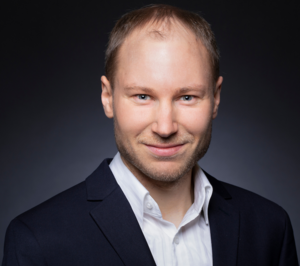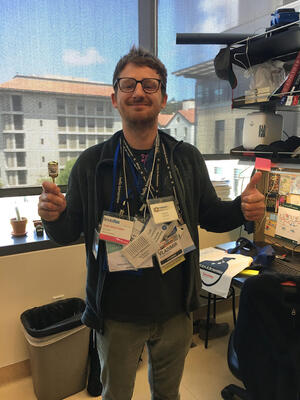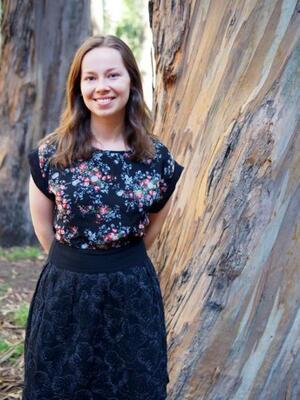 Congratulations to our latest graduates! From left to right, starting on the top row: Timothy Day, Alexander Naka, Vladimir Senatorov, Keven Laboy-Juárez, Amy LeMessurier, Kimberly Long, Elena Ryapolova-Webb, Falk Lieder, Katelyn Arnemann, Wren Thomas, Elizabeth Lorenc. Not pictured: Anwar Nunez-Elizalde.
Congratulations to our latest graduates! From left to right, starting on the top row: Timothy Day, Alexander Naka, Vladimir Senatorov, Keven Laboy-Juárez, Amy LeMessurier, Kimberly Long, Elena Ryapolova-Webb, Falk Lieder, Katelyn Arnemann, Wren Thomas, Elizabeth Lorenc. Not pictured: Anwar Nunez-Elizalde.
Read the Q&A to learn their biggest discoveries, future plans, and words of advice.
Katelyn Arnemann, Jagust lab 
Thesis: Brain networks, aging, and Alzheimer’s disease
What is the most interesting thing you discovered in your research here?
There is relatively limited understanding of why some brain areas, but not others, are afflicted by Alzheimer’s disease pathology. The topological distribution of amyloid-beta plaques is multi-focal, apparently accumulating in numerous distributed brain areas — even in cognitively normal older adults without substantial amyloid-beta pathology (detected by PIB-PET). The earliest brain areas afflicted by amyloid-beta seem to be more closely linked to brain areas exhibiting metabolic tissue vulnerability in young adults — “metabolic inefficiency” in my work — but not highly-connected “hubs” or any particular intrinsic connectivity network. This supports further investigation of the potential role of bioenergetics across the lifespan in explaining the etiology of Alzheimer’s disease.
What are you doing next?
In July 2018 I will begin postdoctoral research with Michael Cole at Rutgers-Newark in the area of computational cognitive neuroscience.
Do you have any advice for your fellow students?
Don’t forget that you’re here for yourself, not anyone else. Periodically, remind yourself why you’re here. It’s a long road — you can’t afford to compromise your wellness. If you want to make it through intact — which you should — you need to maintain your health, your relationships, your sanity, etc. Start healthy habits and set healthy boundaries *now*, and don’t compromise them.
Timothy Day, Flannery lab
Thesis: Expanding the potential of Adeno-Associated Virus for the treatment of intractable inherited retinal degenerations
What is the most interesting thing you discovered in your research here?
The most interesting thing that we discovered is a new adeno-associated virus variant that is much better at delivering therapeutic DNA to cells in the retina. This has the potential to help reverse or prevent blindness in patients with inherited retinal degenerations.
What are you doing next?
I am working at the company that I co-founded called DNAlite Therapeutics where we are focused on developing gene therapy treatments for the gastrointestinal tract.
Do you have any advice for your fellow students?
Definitely reach out to all of the incredibly smart and talented students and facility at Berkeley to collaborate on projects early on. Experiments work better and are more fun to do when you do them with others.
Amy LeMessurier, Feldman lab
Thesis: Tactile experience-dependent refinement of maps and population codes in primary somatosensory cortex
What is the most interesting thing you discovered in your research here?
Maps in primary sensory cortex change dramatically when mice are provided with an enriched environment (in other words, when we give them toys that they can manipulate and explore). Specifically, enrichment enhances the columnar structure of the whisker map in barrel cortex. Individual neurons become more sensitive to input to their anatomically-mapped whisker, and populations of neurons encoding whisker input become more correlated within columns. We still don’t really know whether maps and/or columns are advantageous for sensory coding, but my research suggests that maps are refined when animals experience a greater variety of sensory input.
What are you doing next?
I’m submitting a paper soon and will be filing my thesis in August. After that I will probably do a postdoc, but I’m also looking at data science jobs.
Do you have any advice for your fellow students?
Talk about your projects – with your labmates, other students, non-neuroscience friends, etc. – as much as you can (…well, until it stops being fun). Talking through your reasoning and assumptions can be really useful, especially if your project is mostly solitary.
Falk Lieder, Griffiths lab 
Thesis: Beyond bounded rationality: reverse-engineering and enhancing human intelligence
What is the most interesting thing you discovered in your research here?
The way in which we think and decide is shaped by metacognitive reinforcement learning. We can therefore greatly accelerate the acquisition of cognitive skills by giving people immediate feedback that accurately communicates the long-term value of their cognitive operations.
What are you doing next?
I am moving on to a faculty position at the Max Planck Institute for Intelligent Systems in Tübingen (Germany). My lab will develop theories and tools for understanding and promoting cognitive growth, goal setting, productivity, and goal achievement.
Do you have any advice for your fellow students?
I believe that the best advice I have ever received came from reading Stephen Covey’s “The 7 habits of highly effective people” and Ray Dalio’s “Principles”. I have yet to discover more useful advice of my own.
Elizabeth Lorenc, D’Esposito lab 
Thesis: Neural mechanisms of precision and distractor resistance in visual working memory
What is the most interesting thing you discovered in your research here?
My graduate research contributes to our understanding of how the human brain represents both basic visual features and complex images like human faces and natural scenes in working memory. I found evidence for the recruitment of sensory regions in the maintenance of precise information in memory, and for top-down prefrontal and parietal control processes that shape the selectivity and distractor-resistance of these mnemonic representations.
What are you doing next?
I’ll be moving to Austin in August to begin postdoctoral research in the Lewis-Peacock lab at UT Austin, using fMRI neurofeedback to causally manipulate competition between items in working memory and examine the effects on long-term retention.
Do you have any advice for your fellow students?
You are ABSOLUTELY smart enough for this! Persistence and asking for help when you need it will get you through grad school and beyond. And don’t forget to have fun along the way!
Alex Naka, Adesnik lab 
Thesis: Inhibitory pathways in the neocortical microcircuit
What is the most interesting thing you discovered in your research here?
Working alongside my colleagues in Hillel’s lab, I mapped out the organization of previously undescribed inhibitory circuits in the neocortex. A lot of my work focused on a particular kind of inhibitory interneuron which hadn’t been studied much before – it still doesn’t really have a proper name!
What are you doing next?
I’m headed to an industry postdoc in Dave Hackos’ lab at Genentech.
Do you have any advice for your fellow students?
Winning funding and publishing in prestigious journals are the means to an end: doing good science and disseminating your findings to society. Or at least, that’s how it’s supposed to be –
but the ‘publish-or-perish’ mentality is so pervasive now that I think many people forget this, to everyone’s detriment. So my advice is: remember to always keep sight of the reasons you wanted to be a scientist. And don’t forget to have fun!
Vlad Senatorov, Kaufer lab 
Thesis: Mechanisms and treatment of vascular pathology in the aging brain
What is the most interesting thing you discovered in your research here?
Neurovascular dysfunction is one of the earliest triggers of neurological aging, and the aging brain may retain considerable latent capacity which can be revitalized by inhibiting a key astrocytic regulatory pathway.
What are you doing next?
I co-founded a biotech company, called Palisade Neuroscience, to take our scientific discoveries out of the lab and into the clinic, by developing novel therapeutic approaches for preventing and reversing neurological disease.
Do you have any advice for your fellow students?
Try to work on several projects in parallel, and try to form collaborationswith scientists from different fields.
Elena Ryapolova-Webb, Adesnik lab 
Thesis: Interactions between barrel cortex and primary somatosensory thalamus in the mouse
What is the most interesting thing you discovered in your research here?
Even if a circuit between two regions looks simple, the brain can surprise you and throw curveballs your way, but keep on keeping on!
What are you doing next?
Optimistically unsure! I’ll be casting a wide net with the intent of staying in the Bay Area.
Do you have any advice for your fellow students?
Take time to explore outside the lab – Berkeley, the Bay, and Cali are full of wonderful people
and experiences that will lead you down paths you never knew existed.
—
View all Neuroscience PhD Program graduate Q&As.
Original Publication Date: May 29, 2018
